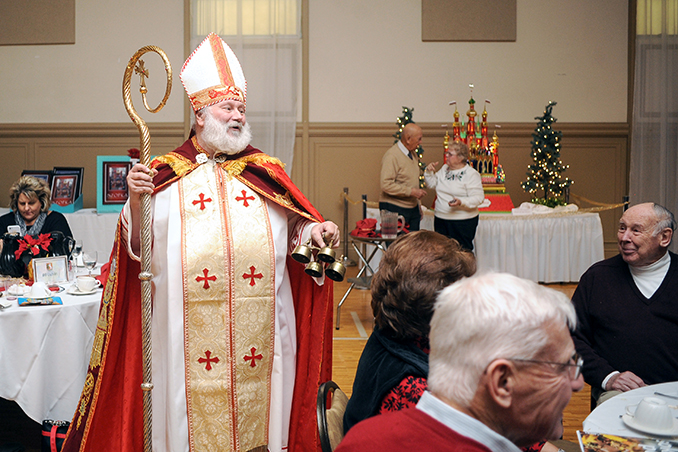
Today as a part of our Christmas series of emails, we invite you to read the story of St. Nicholas below, and then to make your own St. Nick candy bar wrappers. Candy bars make great stocking stuffers, gifts for co-workers, teachers and classmates! To receive our weekly Christmas emails, sign up here.
The Story of St. Nicholas
Written by Samantha Wallace
These days, especially in the West, the day after Thanksgiving marks the official start of the Christmas season (although we’ve all seen Christmas decorations going up for sale as soon as Halloween ends). But for Polish people, including the Polish diaspora living around the world, nothing says the holidays are here like St. Nicholas Day (Dzien Świętego Mikołaja) on December 6.
The day is the feast day of the revered Christian saint, who – through his reputation for protecting and giving gifts to children – is generally acknowledged as the inspiration for Santa Claus. However, Nicholas is still separately celebrated for his own merits and contributions to Christianity, especially in Poland, which has a strong Christian background.
Born during the 3rd century in a village called Patara – in an area of what is now Turkey, but at the time was part of Greece – Nicholas was a devout Christian from a young age, at a time when Christianity was still in its infancy and was still being strongly persecuted in some areas of Greece and eastern Europe. He came from a rich background and inherited sizable wealth when his parents died while he was still a young man, but after his parents’ deaths, he used the wealth he inherited from them to, as Jesus proclaimed, “sell what you own and give the money to the poor” – especially to children. This is, most likely, where the idea of Santa Claus/St. Nicholas giving gifts to children began.
Nicholas’ faith and devotion to the poor earned him love and respect from the Christian community, and he was made Bishop of Myra in Lycia in 317 A.D. Due to the turbulent religious times, he was imprisoned and then exiled under the direction of the Roman Emperor Diocletian, but he was eventually released and attended the pivotal Council of Nicea in 325 A.D., which brought together leading figures in Christianity in order to discuss and solve issues about the early years of the faith.
There are many tales told of Nicholas, most miraculous in nature, about his generosity and protection of children. One story tells of a poor man with three daughters; in older times, a young woman’s father had to offer prospective husbands something of value, known as a dowry, and the larger the dowry, the better the chance that a young woman would find a good husband. Without a dowry, however, a woman was unlikely to marry. This poor man’s daughters, without dowries, were destined to be sold into slavery – but mysteriously, on three different occasions, a bag of gold appeared in their home, providing the needed dowries.
The bags of gold, tossed through an open window, are said to have landed in stockings or shoes left before the fire to dry. This led to the custom of children hanging stockings or putting out shoes for gifts from St. Nicholas. Sometimes the story is told with gold balls instead of bags of gold, which is why three gold balls – often represented as oranges – are one of the symbols for St. Nicholas.
Another story tells of three theological students, traveling on their way to study in Athens when a wicked innkeeper robbed and murdered them, hiding their remains in a pickling vat. It so happened that Bishop Nicholas, traveling along the same route, stopped at the same inn, and in the night he dreamed of the crime, got up, and summoned the innkeeper. As Nicholas prayed to God, the three boys were restored to life.
Nicholas died on December 6, 343 A.D., and he has been recognized as a saint since long before the Catholic Church began regulating canonization procedures in the late 10th century; the Roman emperor Justinian I built a church to honor St. Nicholas in Constantinople as early as the 6th century. The celebration of his life and legacy continue to this day, with Poles commemorating it in their own unique way.
The festivities begin the night before, when stockings are hung by the fireplace in hopes that they will be filled with nuts, tangerines or oranges (emblematic of the gold balls said to have been given by St. Nicholas to the poor man’s daughters), and small gifts by the Saint. In older times, freshly cleaned and polished shoes were set out for these gifts.
Nicholas is said to descend from Heaven that night with an angel helper and travel by sleigh (another inspiration for Santa Claus) to visit homes. It is said that he would give out the small gifts and oranges, and often pierniki, saint-shaped cookies made with honey and spices, as well – the making of which is still a tradition in many areas of Poland. Another older tradition held on feast day was when small boys would dress up as bishops and beg alms for the poor. Old or now, these cherished traditions ensure that the selfless legacy of St. Nicholas will continue in Polish homes around the world.